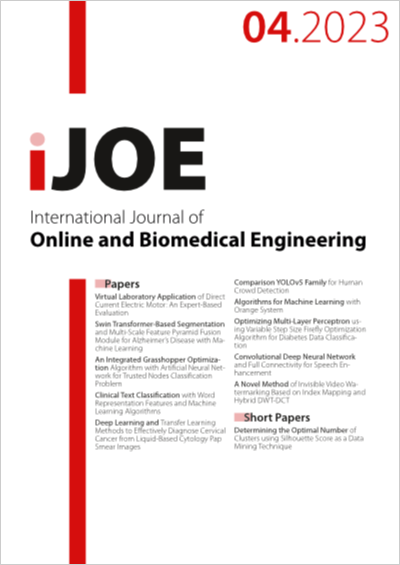Swin Transformer-Based Segmentation and Multi-Scale Feature Pyramid Fusion Module for Alzheimer’s Disease with Machine Learning
DOI:
https://doi.org/10.3991/ijoe.v19i04.37677Keywords:
Alzheimer Disease (AD), Mild Cognitive Impairment (MCI), Skullstriping, Segmentation, VGG-16, Swin TransferAbstract
Alzheimer Disease (AD) is the ordinary type of dementia which does not have any proper and efficient medication. Accurate classification and detection of AD helps to diagnose AD in an earlier stage, for that purpose machine learning and deep learning techniques are used in AD detection which observers both normal and abnormal brain and accurately detect AD in an early. For accurate detection of AD, we proposed a novel approach for detecting AD using MRI images. The proposed work includes three processes such as tri-level pre-processing, swin transfer based segmentation, and multi-scale feature pyramid fusion module-based AD detection.In pre-processing, noises are removed from the MRI images using Hybrid Kuan Filter and Improved Frost Filter (HKIF) algorithm, skull stripping is performed by Geodesic Active Contour (GAC) algorithm which removes the non-brain tissues that increases detection accuracy. Here, bias field correction is performed by Expectation-Maximization (EM) algorithm which removes the intensity non-uniformity. After completed pre-processing, we initiate segmentation process using Swin Transformer based Segmentation using Modified U-Net and Generative Adversarial Network (ST-MUNet) algorithm which segments the gray matter, white matter, and cerebrospinal fluid from the brain images by considering cortical thickness, color, texture, and boundary information which increases segmentation accuracy. After that, multi-scale feature extraction is performed by Multi-Scale Feature Pyramid Fusion Module using VGG16 (MSFP-VGG16) which extract the features in multi-scale which increases the detection and classification accuracy, based on the extracted features the brain image is classified into three classes such as Alzheimer Disease (AD), Mild Cognitive Impairment, and Normal. The simulation of this research is conducted by Matlab R2020a simulation tool, and the performance of this research is evaluated by ADNI dataset in terms of accuracy, specificity, sensitivity, confusion matrix, and positive predictive value.
Downloads
Published
How to Cite
Issue
Section
License
Copyright (c) 2023 Dr. Nasr Gharaibeh, Dr. Ashraf Abu-Ein, Prof. Obaida M. Al-Hazaimeh, Dr. Khalid M.O. Nahar, Dr. Waleed A. Abu-Ain

This work is licensed under a Creative Commons Attribution 4.0 International License.



